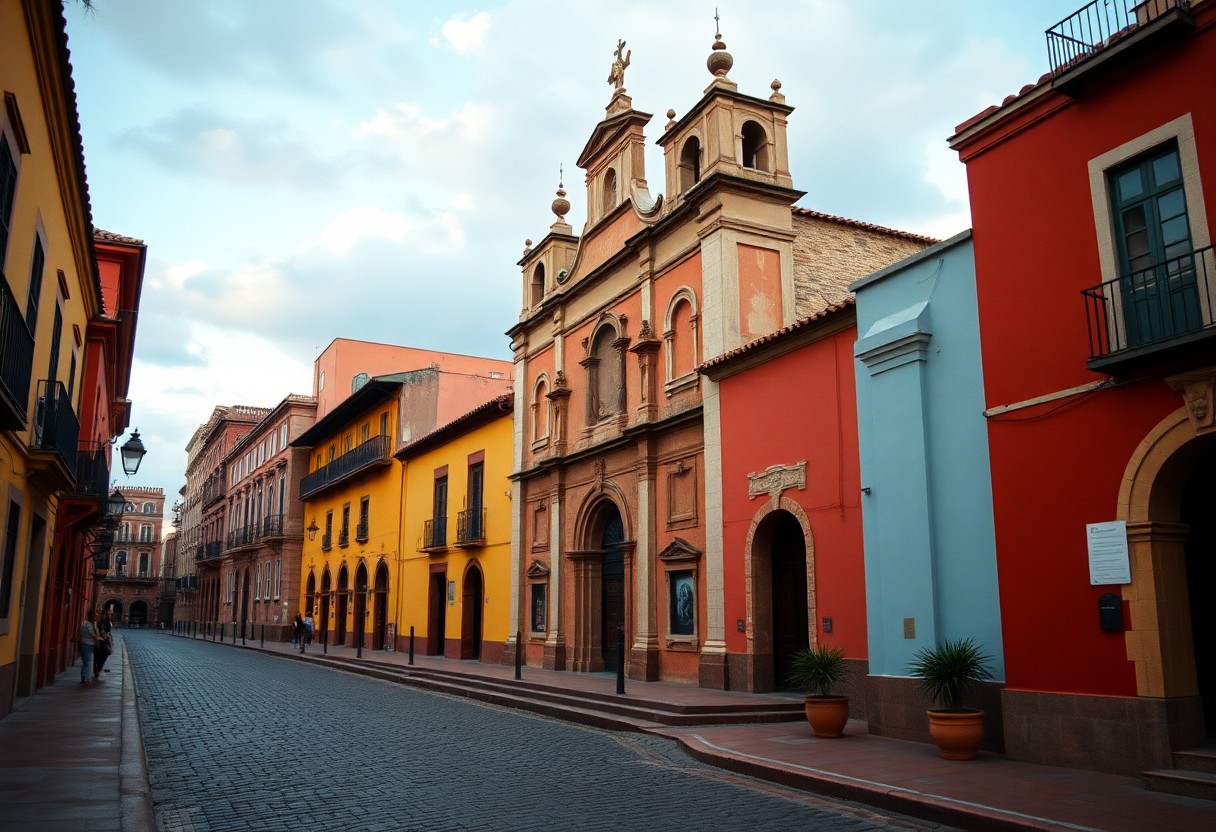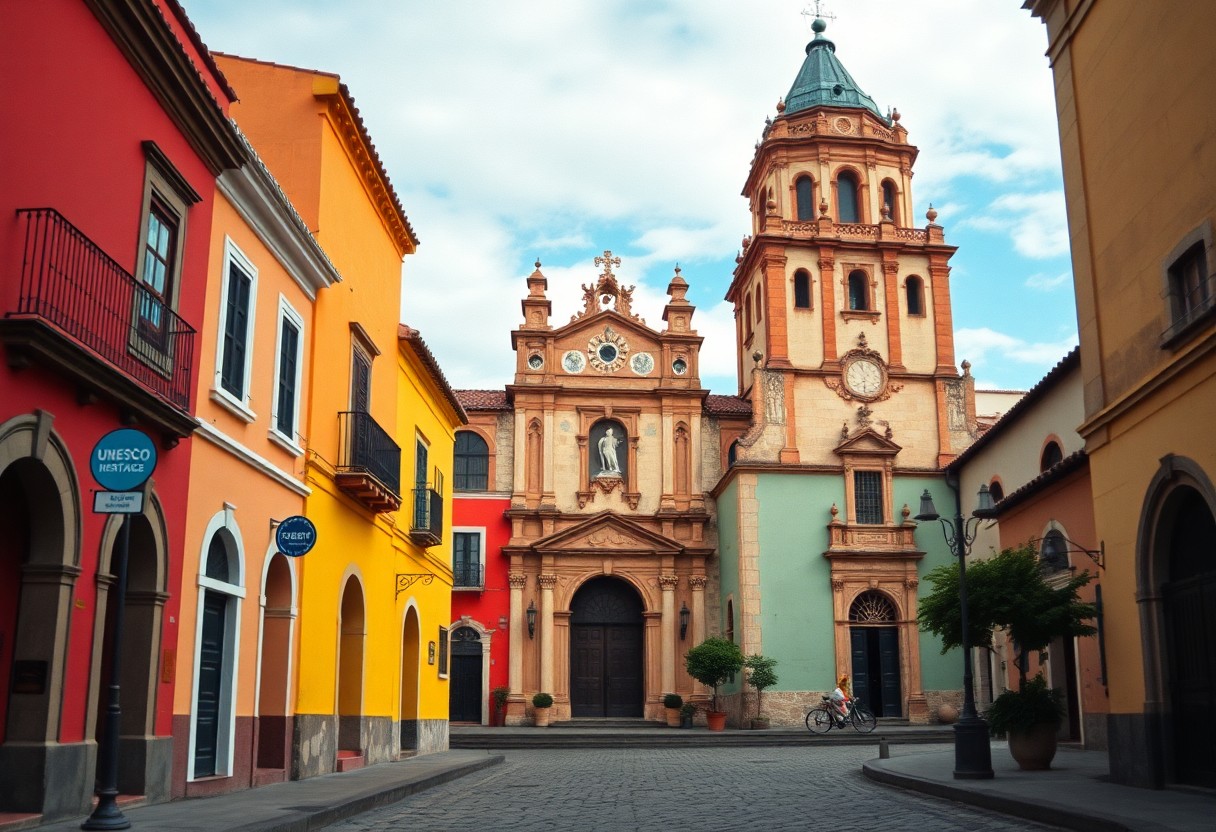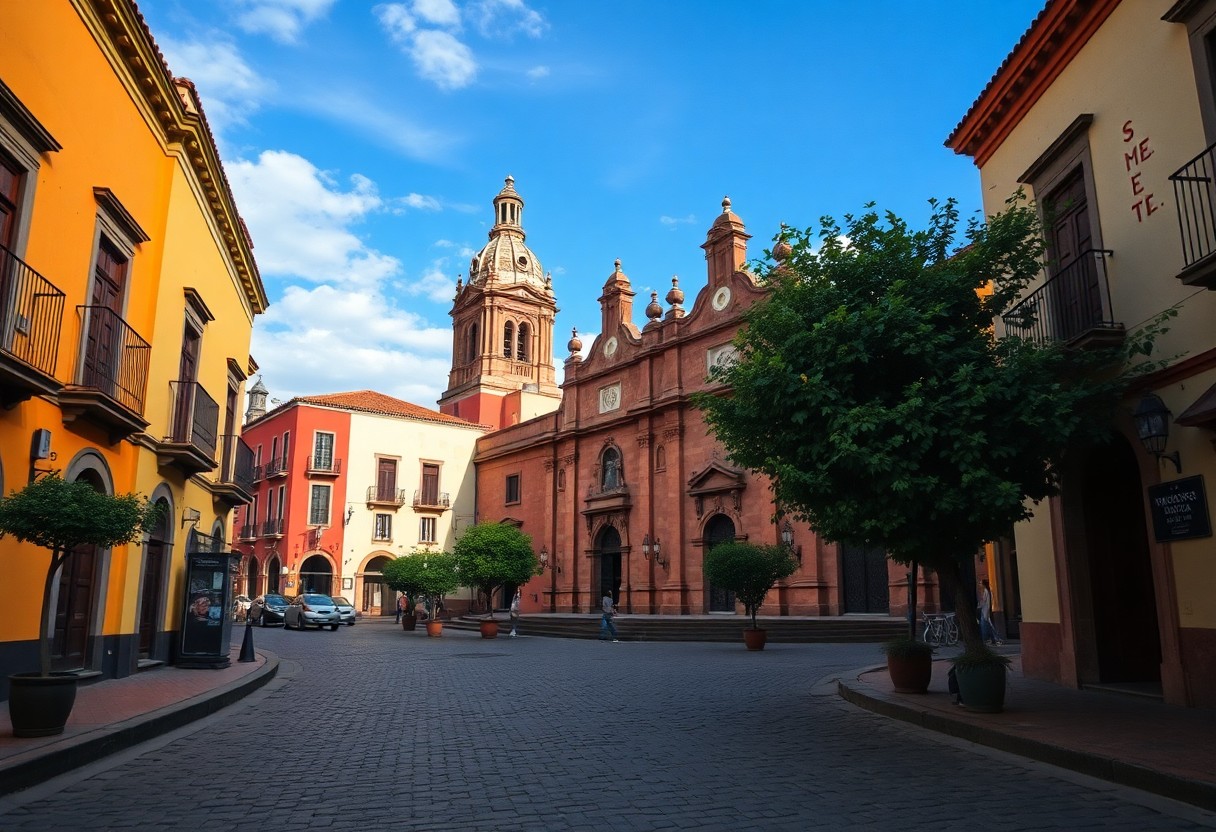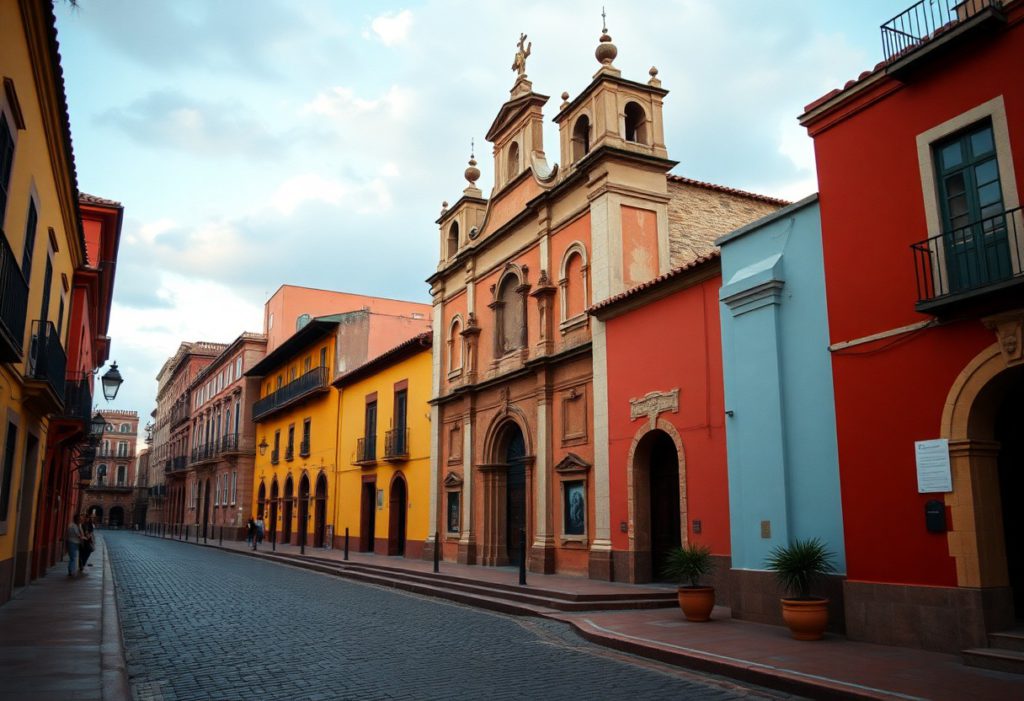In 2008, UNESCO officially recognized San Miguel de Allende as a World Heritage Site, highlighting its exceptional cultural and historical importance. This captivating city exhibits a beautiful blend of Spanish colonial architecture and rich artistic traditions, nestled in the scenic central highlands of Mexico. Established in 1542 by Franciscan monks, San Miguel has transitioned from a pivotal location in the Mexican independence movement to a renowned global cultural destination. As you stroll along its charming cobblestone streets and delve into its meticulously preserved historical center, you'll discover a vibrant testament to Mexico’s diverse architectural and cultural heritage, reinforcing its reputation as one of the most fascinating historical landscapes in the Americas.
Discover the Intriguing Pre-Colonial and Indigenous Heritage of San Miguel de Allende
The land that is now San Miguel de Allende was originally inhabited by a variety of indigenous groups, and its pre-colonial history reveals a rich tapestry of cultural interactions. The region was primarily occupied by the Chichimeca and Otomi peoples, who cultivated advanced societies long before the Spanish arrived. Their strategic settlements in this mountainous area demonstrated remarkable adaptability to the challenging environmental conditions, establishing a robust foundation for the region’s ongoing cultural evolution.
Uncover the Early Settlements and Inhabitants
Archaeological findings suggest that indigenous communities in San Miguel de Allende established intricate social structures between 500 and 1000 CE. These early inhabitants carefully selected sites with natural defensive advantages, leading to the development of settlements designed to protect against potential invasions while also offering sustainable agricultural opportunities. Their thoughtful planning and resource management laid the groundwork for thriving communities that flourished in this dynamic environment.
Investigate the Cultural Practices and Traditions of Indigenous Peoples
Before the onset of Spanish colonization, indigenous societies practiced intricate religious ceremonies and agricultural rituals. Their spiritual beliefs were deeply intertwined with natural cycles, featuring elaborate ceremonies that honored agricultural deities and celestial movements. Central to these practices were advanced agricultural techniques that allowed these communities to prosper despite the challenging terrains. Their profound understanding of local ecosystems, coupled with innovative irrigation methods and crop rotation practices, facilitated sustainable food production and resilience, underscoring their deep-rooted connection to the land.
Their agricultural expertise included inventive strategies that maximized resource utilization, ensuring each community could thrive independently. Such practices not only fulfilled immediate needs but also fostered a strong sense of communal identity and cultural continuity through generations, reflecting the depth of their relationship with their environment.
Analyze the Influence of Indigenous Languages
Among the various indigenous groups, the Otomi and Chichimeca languages were predominant in daily communication. These languages functioned not just as communication tools but as intricate cultural expressions that reflected complex social relationships and worldviews. The linguistic heritage of San Miguel de Allende serves as a rich repository of cultural knowledge, preserving an elaborate understanding of local ecosystems, medicinal practices, and social structures. This linguistic diversity constitutes a living archive of generational wisdom that transcends mere verbal communication.
These languages encapsulated profound narratives and traditions that shaped the community’s relationship with their environment. Thus, the preservation of these languages remains crucial for maintaining cultural identity and continuity, showcasing the enduring legacy of the region's indigenous heritage.
Investigate the Spanish Colonial Era of San Miguel de Allende
San Miguel de Allende emerged as a pivotal Spanish colonial settlement in the early 16th century, fundamentally reshaping the landscape of New Spain. This region became a strategic site for Spanish conquistadors, establishing a complex administrative and cultural framework that would significantly influence the city’s trajectory for centuries. By examining this period, you will uncover the notable impact of colonial governance on indigenous populations and territorial expansion, which shaped the socio-political dynamics of the region.
Trace the Founding of San Miguel de Allende
In 1542, Friar Juan de San Miguel founded the settlement in the fertile valleys of central Mexico, selecting a location that would evolve into a key administrative hub. This moment highlights the strategic importance of establishing a Spanish presence in the area, creating a center for cultural exchange and territorial control that would have lasting implications for the region's development.
Evaluate Architectural Developments and Urban Planning
The urban landscape of San Miguel de Allende reflects the elegant Spanish colonial architectural style. You will observe how baroque and neoclassical influences reshaped the city’s physical environment, resulting in a harmonious blend of European design principles and local craftsmanship. This architectural evolution not only enhanced aesthetic appeal but also served functional purposes, ensuring that structures met the needs of a burgeoning population.
Central to San Miguel de Allende’s architectural advancement were meticulous urban planning strategies that focused on both aesthetic and functional considerations. The city's layout, characterized by wide streets, central plazas, and impressive ecclesiastical and governmental buildings, exemplifies a sophisticated approach to urban design that seamlessly integrates beauty with practical urban infrastructure. This planning established a vibrant civic life that continues to thrive today.
Explore Economic Growth and Agricultural Practices
The colonial period witnessed significant advancements in agriculture and trade, positioning San Miguel de Allende as a critical economic center. You will discover how silver mining, textile production, and agricultural exports propelled the city’s prosperity and regional importance, establishing it as a key player in the broader economic landscape of New Spain.
As a result, San Miguel de Allende’s economic landscape expanded dramatically, fostering complex trade networks that connected local producers to broader regional and international markets. The diversification of economic activities, including agriculture, mining, and artisanal production, created a robust economic ecosystem that supported the city's growth and development throughout the colonial era, enhancing its historical significance.

Examine San Miguel de Allende During the War of Independence
Your exploration of San Miguel de Allende during the independence era uncovers a critical chapter in Mexican history. In the early 19th century, the town became a significant battleground where colonial resistance and revolutionary fervor converged. Its strategic positioning and passionate inhabitants transformed it from a tranquil colonial settlement into a hotbed of revolutionary activity.
Highlight Key Figures in the Independence Movement
Any examination of San Miguel’s independence narrative must underscore the contributions of local heroes, particularly Ignacio Allende, a native son who played a vital role in challenging Spanish colonial authority. His strategic thinking and unwavering dedication to liberation inspired many townspeople to rally behind the revolutionary cause, making San Miguel a crucial launching point for the independence movement.
Analyze Major Events and Battles in the Area
San Miguel de Allende was the scene of significant battles that marked pivotal moments in Mexico’s quest for independence. The town witnessed intense military confrontations between insurgent forces and Spanish troops, with local fighters exhibiting remarkable bravery and strategic ingenuity in their pursuit of national sovereignty. The region’s geographical advantages enabled revolutionary leaders to orchestrate complex military operations, successfully disrupting Spanish colonial control.
As you delve deeper into the independence narrative, you will uncover that numerous strategic military engagements occurred in and around San Miguel de Allende, significantly influencing the region’s revolutionary path. Insurgent forces skillfully utilized the local terrain to their advantage, demonstrating their tactical prowess in the face of colonial opposition.
Assess the Aftermath and Impact on the Town
The struggle for independence left an indelible mark on San Miguel’s community, reshaping its social and physical landscape. The conflict dismantled existing power structures, challenged colonial hierarchies, and ignited a renewed sense of national identity among residents who fervently fought for liberation. This transformative period altered local demographics and economic frameworks, influencing the city’s future development.
The aftermath of the revolutionary period introduced noteworthy social mobility, empowering local populations while paving the way for urban advancement. Economic disruptions caused by prolonged conflict were gradually rectified as the town embraced its new national identity, leading to the revitalization of infrastructure and the establishment of innovative community structures.
Understand the French Intervention and Its Effects
The French intervention in Mexico represents a transformative period for San Miguel de Allende. This conflict, which lasted from 1861 to 1867, profoundly impacted the city’s social and political landscape. The French invasion, backed by European powers, challenged Mexico’s sovereignty and caused significant disruption to local communities, introducing complex geopolitical dynamics that would influence the region's future.
Investigate the Role of San Miguel de Allende in the Conflict
Following the entry of French troops into Mexico, you will observe that San Miguel de Allende became a strategic stronghold for resistance movements. Local patriots actively opposed foreign intervention, bolstering national defense efforts and providing refuge to revolutionary fighters. The city emerged as a powerful symbol of Mexican resistance against imperial ambitions, embodying a spirit of defiance.
Examine Changes in Governance and Society
The French intervention triggered significant administrative restructuring in San Miguel de Allende, leading to profound shifts in local governance. New political structures emerged, fundamentally challenging traditional power dynamics during this tumultuous period. This intervention catalyzed comprehensive societal transformations, altering social hierarchies and introducing new economic models that would change the city’s developmental trajectory for generations.
Explore Cultural Shifts Resulting from Foreign Influence
Before the intervention, San Miguel de Allende maintained a relatively insular cultural environment. However, European interactions during this period introduced fresh artistic, architectural, and intellectual perspectives that gradually transformed the city’s cultural landscape. The infusion of new ideas and practices reshaped local traditions, creating a unique hybrid cultural identity that would define San Miguel in the subsequent years.
As a consequence of the French intervention, a complex cultural exchange emerged, profoundly influencing San Miguel de Allende. The city began to incorporate European aesthetic sensibilities, educational practices, and technological innovations, enriching its cultural tapestry and fostering a vibrant environment for creative expression.
Analyze the 19th Century Transformation of San Miguel de Allende
Throughout the 19th century, San Miguel de Allende experienced a significant transformation that reshaped its social, economic, and political landscape. This period marked a crucial turning point in the city’s history, transitioning from a colonial outpost to a more dynamic urban center with increasing national prominence. The changes that occurred during this time laid the groundwork for the city's vibrant modern identity.
Assess Industrialization and Urban Development
The emergence of new economic activities and infrastructure dramatically transformed San Miguel de Allende’s urban landscape. You would witness remarkable industrial advancements that introduced textile mills, manufacturing facilities, and enhanced transportation networks, gradually modernizing the city’s economic structure and physical environment. These developments facilitated increased economic activity and a more interconnected community.
Investigate Changes in Demographics and Migration Patterns
Alongside economic shifts, significant demographic transformations unfolded during this time. Population dynamics began to evolve, marked by increased internal migration and the arrival of new settlers eager to seize economic opportunities in the burgeoning urban landscape. This influx of people contributed to a complex demographic reconfiguration, enriching the city’s social fabric.
As San Miguel de Allende progressed through the 19th century, rural populations migrated to the city, bringing diverse skills and cultural backgrounds. The integration of indigenous communities, mestizo populations, and emerging middle-class groups resulted in a more heterogeneous social composition, fundamentally altering the city’s social structure and enhancing its cultural richness.
Explore the Role of San Miguel de Allende in National Politics
San Miguel de Allende’s political importance became increasingly evident during this transformative period. The city emerged as a key political center in regional and national movements, with local leaders playing influential roles in broader Mexican political discourse. This era saw the city contributing significantly to national conversations about identity and governance.
San Miguel de Allende became a vital focal point for political action during Mexico’s tumultuous independence and reform periods. Understanding the influential political figures and intellectual movements that originated from this city deepens your appreciation for its contributions to the national narrative, showcasing how local dynamics can shape broader historical trajectories.
Celebrate the Cultural Flourishing of the 20th Century
Despite facing economic challenges, San Miguel de Allende experienced a remarkable cultural renaissance in the 20th century. You will discover how the city transformed from a quiet colonial town into a vibrant artistic hub, attracting creative minds from across the globe. The influx of international artists, writers, and intellectuals revitalized its historic streets, establishing San Miguel as a prominent cultural destination that ultimately earned UNESCO World Heritage status.
Understand the Arrival of Artists and Intellectuals
To appreciate San Miguel’s artistic evolution, consider how creative individuals were drawn to its unique charm. Renowned artists and writers recognized the city’s magical atmosphere, perceiving it as a sanctuary for artistic expression. The town’s colonial architecture, vibrant colors, and welcoming community became an irresistible magnet for international talents seeking inspiration within a new cultural landscape.
Examine the Formation of Art Institutions and Workshops
An extraordinary transformation unfolded with the establishment of groundbreaking art institutions. The Instituto Allende and other art schools became pivotal in nurturing a robust artistic ecosystem. These institutions provided spaces for learning, collaboration, and artistic growth, attracting students and professionals from diverse backgrounds.
Moreover, these art institutions played a crucial role in preserving and promoting traditional Mexican artistic techniques. They offered comprehensive programs in painting, sculpture, ceramics, and other visual arts, ensuring that both local and international artists could refine their skills within a rich, supportive environment. Workshops became hubs of cultural exchange and artistic innovation, further enriching the city’s creative landscape.
Explore the Impact of the Mexican Revolution on the City
The Mexican revolutionary movements profoundly influenced San Miguel’s cultural landscape. You will observe how political changes sparked artistic expressions and social transformations. The city emerged as a symbolic space for revolutionary ideals, with artists and intellectuals utilizing their creative platforms to explore themes of social justice and national identity.
Artists and intellectuals who arrived in San Miguel during and after the revolution brought powerful narratives of social change. They transformed the city into a dynamic cultural laboratory, where artistic expression became a powerful means of exploring national identity, social struggles, and cultural heritage. Their contributions reshaped San Miguel’s intellectual and artistic dialogue, establishing it as a significant center for creative and political discourse.
Experience San Miguel de Allende as an Expat Haven
San Miguel de Allende has evolved into a magnetic destination for international artists, retirees, and creative professionals. You will find a vibrant expatriate community drawn to its colonial charm, affordable living, and rich cultural landscape. The city’s inviting atmosphere and artistic heritage have made it a global hotspot for individuals seeking a fresh start beyond their original borders.
Observe the Rise of the Expat Community
Amid traditional Mexican life, an international community began to flourish. You will discover that artists from the United States, Canada, and Europe were initially attracted by the Instituto Allende and the city’s burgeoning artistic reputation. Their arrival gradually altered San Miguel’s demographic landscape, creating a unique fusion of local and international cultures.
Investigate Cultural Exchange and Influence
By integrating into the local community, expatriates brought transformative perspectives. You will notice how they contributed to artistic workshops, language exchanges, and cultural events that enriched San Miguel’s social fabric. Their presence fostered a dynamic environment of mutual learning and appreciation, enhancing the cultural richness of the city.
This cultural interchange transcended superficial interactions. Expatriates actively engaged with local traditions, supporting artisan markets, participating in festivals, and learning Spanish. They became integral contributors to San Miguel’s social ecosystem, helping preserve traditional crafts while introducing global perspectives that further diversified the city’s cultural offerings.
Analyze the Economic Implications of Expatriation
For San Miguel, the influx of expatriates represented significant economic opportunities. You will see how foreign residents stimulated real estate markets, established service industries, and injected substantial investments into the local economy. The economic impact of expatriates extended far beyond direct financial contributions.
They opened businesses, launched galleries, restaurants, and language schools, creating employment opportunities for local residents. Their entrepreneurial spirit transformed San Miguel into a thriving international hub, attracting global attention and diversifying the city’s economic landscape while fostering local growth.
Examine Architecture and Preservation Efforts in San Miguel de Allende
The architectural elements of San Miguel de Allende showcase a stunning blend of colonial Spanish and indigenous Mexican design. You will uncover an extraordinary preservation of baroque, neoclassical, and Mexican baroque architectural styles that define the city’s unique visual identity. The community's commitment to maintaining its historical aesthetic has been fundamental in achieving its UNESCO World Heritage Site recognition, ensuring that visitors can experience an authentic glimpse into Mexico’s rich architectural legacy.
Identify Notable Historical Buildings and Their Significance
At the heart of San Miguel de Allende stand iconic structures that narrate the city’s historical journey. You will be captivated by the Parroquia de San Miguel Arcángel, a pink-stone church featuring a distinctive neo-gothic facade, and the Instituto Allende, a former hacienda turned cultural center. These buildings symbolize more than architectural marvels; they embody the city’s cultural evolution and artistic spirit, serving as vital landmarks in its historical narrative.
Explore Restoration Projects and Community Involvement
San Miguel de Allende has developed community-driven restoration initiatives aimed at careful preservation over decades. You will find local artisans, historians, and residents actively participating in maintaining the city’s architectural integrity. These collaborative efforts ensure that historical buildings are not only preserved but continue to serve modern community needs, striking a balance between the past and contemporary requirements.
Furthermore, the restoration projects extend beyond mere structural repairs. You will witness comprehensive approaches that include training local craftsmen in traditional building techniques, documenting architectural histories, and creating sustainable conservation models. These initiatives not only protect physical structures but also preserve cultural knowledge and skills passed down through generations, ensuring that the spirit of San Miguel endures.
Evaluate Challenges in Conservation
Every preservation effort encounters complex challenges in balancing historical authenticity with modern development. You will find ongoing debates about maintaining architectural integrity while accommodating urban growth. Limited funding, environmental factors, and the delicate nature of historical structures present significant obstacles to conservation endeavors.
The significance of these conservation challenges extends far beyond physical restoration. You will understand that preserving San Miguel de Allende’s architectural heritage involves navigating intricate economic, social, and cultural dynamics. The continuous dialogue between preservation experts, local communities, and governmental bodies is crucial for developing holistic strategies that protect the city’s unique architectural landscape while addressing modern needs.
Follow the March Towards UNESCO World Heritage Status
San Miguel de Allende’s extraordinary cultural significance propelled it toward international recognition. You will discover how this enchanting city transformed from a local treasure into a globally acknowledged heritage site. The journey involved meticulous documentation, passionate advocacy, and a compelling narrative of architectural and historical preservation that ultimately captured UNESCO’s attention.
Understand the Nomination Process
Behind every UNESCO designation lies an intricate nomination strategy. You would witness Mexico’s cultural authorities meticulously preparing comprehensive documentation highlighting San Miguel’s unique architectural and historical characteristics. The process demanded exhaustive research, detailed architectural surveys, and a persuasive argument that demonstrated the city’s exceptional universal value, emphasizing its importance within the global heritage community.
Examine Criteria and Evaluation by UNESCO
UNESCO’s stringent international standards guided their assessment of San Miguel de Allende’s candidacy. You would appreciate the rigorous evaluation process that examined architectural integrity, historical significance, and cultural authenticity. The city’s colonial urban landscape and preservation of artistic heritage became pivotal in its assessment, showcasing its unique contributions to global culture.
Moreover, UNESCO’s evaluation delved into San Miguel’s architectural evolution, exploring how the city’s urban fabric represents a remarkable blend of indigenous and Spanish colonial design principles. The organization scrutinized building typologies, urban planning, and the preservation of historical structures, ensuring that every aspect met international heritage conservation standards.
Recognize the Official Recognition and Its Implications
UNESCO’s recognition transformed San Miguel de Allende into a globally celebrated cultural landmark. You would understand that this designation brought international prestige, increased tourism potential, and enhanced preservation commitments. It signified more than just a title for San Miguel de Allende; it opened doors to significant economic and cultural opportunities.
This recognition attracted international funding for conservation efforts, increased global visibility, and a renewed commitment to preserving architectural and cultural heritage, showcasing the city’s rich history and vibrant future.

Investigate the Significance of UNESCO Status for San Miguel de Allende
Today, San Miguel de Allende’s UNESCO World Heritage designation marks a pivotal moment in its historical narrative, elevating its global cultural significance. This international recognition underscores the city’s exceptional architectural and cultural heritage, positioning it as a premier destination of exceptional historical value. You’ll find that this status not only celebrates its colonial beauty but also ensures comprehensive protection and global acknowledgment of its unique urban landscape.
Explore Economic Benefits and Tourism
Achieving UNESCO status has led to a substantial boost in international tourism for San Miguel de Allende. You can observe how this recognition attracts art enthusiasts, historians, and cultural travelers from around the globe, significantly enhancing the local economy. The designation serves as a powerful marketing tool, drawing visitors who seek authentic, historically rich experiences within a meticulously preserved colonial environment.
Assess Cultural Preservation Efforts
As a UNESCO site, San Miguel de Allende has intensified conservation strategies for its architectural and cultural heritage. You’ll notice heightened preservation protocols that safeguard historical structures, traditional crafts, and urban landscapes. This recognition ensures systematic documentation and maintenance of the city’s unique cultural assets, reinforcing its commitment to heritage preservation.
This framework provides comprehensive guidelines for protecting architectural integrity, supporting restoration projects, and implementing strict measures for urban development. Specialized conservation teams work diligently to maintain the city’s historical character, ensuring that every restoration project respects original architectural elements and traditional construction techniques.
Evaluate Community Identity and Pride
The economic recognition from UNESCO status has profoundly transformed community perception. You’ll witness how residents have developed a deeper appreciation for their historical legacy, viewing their city as a globally significant cultural treasure. This recognition fosters a profound sense of collective identity among the community.
These benefits extend beyond economic metrics, as residents increasingly engage in cultural education, participate in preservation initiatives, and take pride in sharing their rich heritage. The UNESCO designation has empowered the community to become active custodians of their cultural narrative, strengthening intergenerational connections and promoting local traditions.
Explore San Miguel de Allende Today
After achieving UNESCO World Heritage status, San Miguel de Allende has transformed into a vibrant, internationally recognized destination that seamlessly blends historical preservation with contemporary cultural dynamism. You’ll find a city that attracts artists, expatriates, and travelers from around the world while maintaining its distinctive colonial charm and architectural beauty.
Discover the Modern Cultural Scene
For decades, San Miguel de Allende has been a magnet for creative professionals. You’ll discover a thriving arts community with numerous galleries, workshops, and cultural institutions that celebrate both traditional Mexican crafts and contemporary artistic expressions. The city hosts world-renowned art schools and festivals that draw talent from across the globe, enriching its cultural landscape.
Analyze Balancing Tourism with Local Life
Cultural preservation remains a delicate balance in San Miguel de Allende. You’ll witness a careful negotiation between welcoming international visitors and protecting the city’s authentic character. The local community works diligently to ensure that tourism benefits residents while preserving the city’s unique social fabric.
Local residents have developed sophisticated strategies to integrate tourism into their daily lives. You’ll observe how neighborhoods have adapted by creating spaces that serve both visitors and long-term inhabitants. Small businesses, artisan workshops, and community initiatives have emerged as ways to maintain economic sustainability while preserving cultural integrity, creating a harmonious coexistence.
Identify Ongoing Challenges and Opportunities
After years of growth, San Miguel de Allende faces complex development challenges. You’ll see ongoing discussions about urban infrastructure, environmental sustainability, and maintaining the city’s historical authenticity amid increasing global interest. The city stands at a critical juncture of development and preservation, navigating these challenges thoughtfully.
Today, San Miguel de Allende is poised at a crossroads of development and preservation. You’ll witness innovative approaches to urban planning that aim to protect the city’s architectural heritage while accommodating modern needs. Economic diversification, sustainable tourism strategies, and community-driven initiatives are key focus areas for ensuring the city’s continued vitality and global significance.

Anticipate Future Prospects for San Miguel de Allende
For San Miguel de Allende, the future appears promising and dynamic. You can anticipate ongoing growth as a cultural and artistic destination, with increasing global recognition. The city’s unique blend of historical preservation and modern innovation positions it as a model for sustainable urban development. Your understanding of its potential will be shaped by ongoing efforts to balance tourism, cultural heritage, and local community needs.
Examine Sustainable Development and Environmental Concerns
Above all, San Miguel de Allende is focusing on green initiatives to protect its natural environment. You will see emerging strategies for water conservation, renewable energy implementation, and ecological preservation. The city aims to develop urban planning that respects its historical landscape while addressing contemporary environmental challenges, ensuring a sustainable future.
Investigate the Role of Technology in Preservation
Alongside traditional methods, San Miguel de Allende is embracing digital technologies for cultural conservation. You can expect advanced digital mapping, virtual reality experiences, and innovative documentation techniques to help preserve the city’s architectural and cultural heritage for future generations.
In fact, technological preservation goes beyond simple documentation. You will witness sophisticated 3D scanning technologies creating precise digital replicas of historical structures, allowing for detailed architectural analysis and potential restoration work. Advanced preservation techniques enable experts to study and protect delicate historical sites with unprecedented accuracy, ensuring their legacy endures.
Ensure Inclusivity in Growth
Between economic development and cultural preservation, San Miguel de Allende is committed to inclusive community growth. You will observe initiatives that support local artisans, provide educational opportunities, and ensure that economic benefits are equitably distributed across different social groups. This commitment to inclusivity is vital for fostering a harmonious community.
Ensuring economic equity remains a priority for San Miguel de Allende. You can anticipate programs designed to empower local communities, including skill development workshops, entrepreneurship support, and strategies that prevent the displacement of long-term residents during urban transformation processes, fostering resilience and stability.
Gather Stories from Residents: Oral Histories and Personal Narratives
To truly appreciate the rich tapestry of San Miguel de Allende, you must delve into the personal stories of its inhabitants. These narratives weave together a complex picture of the city’s social fabric, revealing intimate details about its transformation from a colonial outpost to a vibrant cultural hub. Through oral histories, you’ll uncover the emotional landscape that defines this extraordinary place, capturing the essence of community, resilience, and cultural identity.
Discover Perspectives from Long-Term Residents
Along the cobblestone streets, long-term residents share generational memories that illuminate San Miguel’s evolution. You’ll hear tales of traditional life, economic shifts, and the gradual transformation of their beloved city. Their stories provide a deep historical context that transcends official records, offering you a personal window into the city’s complex social dynamics and cultural changes.
Explore Experiences of Newcomers and Expats
Histories of newcomers reveal the magnetic attraction of San Miguel de Allende. You’ll learn how artists, writers, and entrepreneurs have been irresistibly drawn to this unique destination, finding inspiration in its vibrant culture and artistic community. Their narratives showcase the city’s international appeal and its ability to welcome diverse perspectives, enriching the local tapestry.
In fact, expat experiences in San Miguel are remarkably diverse. You’ll discover stories of individuals who began as tourists but became permanent residents, enchanted by the city’s charm, affordable living, and dynamic cultural environment. Many have established thriving businesses, art studios, and community organizations, significantly contributing to the city’s cosmopolitan character and economic development.
Reflect on Anecdotes that Illustrate the City’s Evolution
Before the UNESCO recognition, San Miguel de Allende underwent profound transformations. You’ll encounter stories that highlight the city’s remarkable resilience through economic challenges, artistic movements, and social changes. These anecdotes provide you with a nuanced understanding of how the city has continually reinvented itself, responding to both internal and external pressures.
Thus, the city’s evolution is a tapestry of personal experiences. You’ll learn about architectural preservation efforts, cultural festivals, and community initiatives that have shaped San Miguel’s identity. These stories illustrate how individual actions collectively contribute to the city’s ongoing narrative, creating a dynamic and living historical entity that thrives on its past while looking forward.
Reflect on How the Past Shapes San Miguel de Allende Today
Unlike many historical cities, San Miguel de Allende has transformed its colonial legacy into a vibrant contemporary cultural destination. You can witness how its rich history continues to influence every aspect of urban life, from architectural preservation to artistic expression. The city’s UNESCO World Heritage status has not only protected its stunning heritage but also attracted global artists, entrepreneurs, and travelers seeking an authentic Mexican experience. Your exploration of San Miguel reveals a living museum where past and present seamlessly intertwine, demonstrating how historical roots can nurture a dynamic, creative community that honors its origins while embracing innovation.
Frequently Asked Questions (FAQ)
What are the colonial origins of San Miguel de Allende?
San Miguel de Allende was founded in 1542 by Franciscan monk Fray Juan de San Miguel. The town emerged as a strategic location in New Spain, serving as a vital connection point between silver mining regions and major trade routes. Its initial purpose centered on protecting Spanish settlers and facilitating economic development in the Bajío region of central Mexico.
How did San Miguel de Allende become a UNESCO World Heritage Site?
In 2008, UNESCO recognized San Miguel de Allende for its exceptional architectural and cultural significance. The city’s well-preserved colonial Spanish architecture, vibrant arts scene, and historical importance in Mexico’s independence movement contributed to its World Heritage designation. The urban landscape showcases remarkable baroque and neoclassical styles that reflect the town’s rich historical narrative.
What role did San Miguel play in Mexico’s independence movement?
San Miguel was a pivotal location during Mexico’s struggle for independence from Spanish colonial rule. Revolutionary leaders like Ignacio Allende, a native of the city, organized key strategic meetings here. The town became a critical center for revolutionary planning, with many significant events unfolding within its historic streets. Its residents played an instrumental role in challenging Spanish colonial authority and supporting the independence movement.
The Article: The History of San Miguel de Allende: From Colonial Roots to UNESCO Status appeared first on https://fallinginlovewithsanmiguel.com/
The Article San Miguel de Allende: From Colonial Heritage to UNESCO Recognition Was Found On https://limitsofstrategy.com


